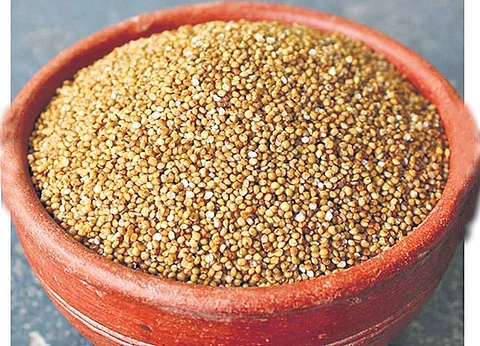

CHENNAI: Keeping our health in check is a priority nowadays, but it’s hard to resist the snacks we have readily available in our kitchens. And since no one’s around to judge us when we’re homebound, how can one not give in to unhealthy but tasty foods? The myth that healthy is not as delicious as the greasy and the fried is easily busted by the variety of millet recipes floating on social media.
A versatile ingredient to incorporate into your routine is the kodo millet, which is commonly consumed in the form of idli, dosa, pongal and upma in south India. You could even try making idiyappam, payasam, adai, or soup to experiment with the millet. “When we have recipe competitions, people even prepare tasty and nutritious cookies with the millet”, says Dr P V Lakshmi, chief dietitian of Gleneagles Global Health City.
Known to have originated in tropical Africa, kodo millet or Paspalum scrobiculatum is believed to have been cultivated in India for 3000 years. This fibre-rich crop is quite widespread in the country, adopting a gamut of names in various languages — Kodra (Hindi and Gujarati), Varagu (Tamil), Arikelu (Telugu), and Haraka (Kannada).

A drought-resistant crop, kodo can be grown on gravelly, poor soil or loamy, rich soil, in Kharif or Rabi season. The flexibility in its farming process allows it to be grown by farmers in several areas of the nation. Currently, Kodo is cultivated in Madhya Pradesh, Tamil Nadu, Maharashtra, Karnataka, Chhattisgarh, and the Jhum fields of Arunachal Pradesh.
The crop is generally grown in warm and dry conditions, where it can survive as little as 40-50 cm rainfall. As a short crop, the millet can be harvested within 100-120 days of planting. The crops are cut close to the ground and then bundled and stacked. After a week, they are threshed and the grains are cleaned by winnowing.
While there are endless ways to use millets in your diet, the transition from rice and wheat is extremely sluggish due to some misconceptions. “These millets are not boring. They adopt the flavour in which we cook it. It’s more like rice. You can make any dish for which you typically use rice, with millets too. Be it carrot rice, tomato rice, sambar rice etc”, explains Ashwanandhini Govindarajan, a food regulatory specialist and home chef. She also shares her favourite kodo recipe.
The millet is the richest source of fibre in the cereals and millets family. This and other properties of the millet lend various nutritional benefits to its consumers, as further elaborated by Dr Lakshmi.
For improved digestion
High fibre content and low fat make it effective in maintaining a healthy digestive system and help with constipation.
Keeps the heart in check
Hypertension or high blood pressure is a growing issue in India. Kodo helps control blood pressure and is great for those with hypertension and other cardiac patients due to its high fibre and low fat.
Good for weight watchers
Since the millet is rich in fibre, kodo is filling even in small quantities. Hence, those who are looking to lose weight or reduce food consumption can opt for this millet.
Healthy option for kidney patients
The millet contains low amounts of phosphorus. This makes it a great food option for kidney patients. People who require peritoneal dialysis due to kidney failure would benefit from consuming kodo.
Balances blood sugar
A glycemic index indicates how fast a certain food can increase blood glucose levels. With a very low glycemic index, kodo keeps a check on blood sugar and is thus, a great food source for those suf fering from diabetes.
Helps those with Cholelithiasis
Cholelithiasis or gallstone formation refers to solid masses formed in the gallbladder or biliary tract, generally due to high cholesterol. Deficient in fat content and abundant in fibre, the millet is good for those suffering from Cholelithiasis.
Kodo millet pongal
by Ashwanandhini Govindarajan (@ashwanandhinigovindarajan)
INGREDIENTS
Kodo millet: ½ cup
Moong dal: 2.5 tbsp
Water: 1 cup, Milk: 1 cup
Grated ginger: ½ to 1 tsp
Whole peppercorn: 1 tsp
Cumin seeds: 1 ½ tsp
Ghee, oil, cashews, curry leaves and salt as required
Preparation: Soak the millet for 10 minutes before cooking.
METHOD
Cook the dal and millet in a pressure cooker on medium flame for 2 ½ whistles. Then set aside for the pongal to cook with the steam.
Heat ghee and oil in a pan and add crushed cumin and peppercorn.
Once roasted, add in the curry leaves. Combine this tempering with the cooked pongal.
Add salt to taste.
Milk is optional but always better to use. You can use milk to adjust the consistency of the pongal as per
your liking.
Mix well and serve hot with sambar, chutney and medhu vada for a delicious breakfast.
End the meal with piping hot filter coffee to wash it down!
NUTRITIONAL VALUE FOR KODO MILLET (PER 100 G)
Energy: 363 kcal
Protein: 8.3 g, Fibre: 9 g
Minerals: 2.6 g, Fat: 1.4 g
Carbohydrates: 65 g